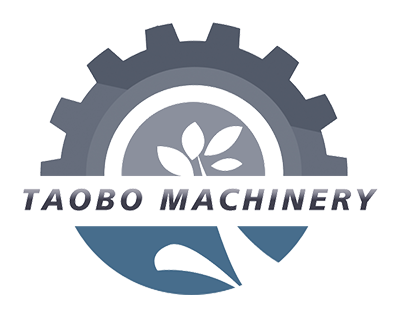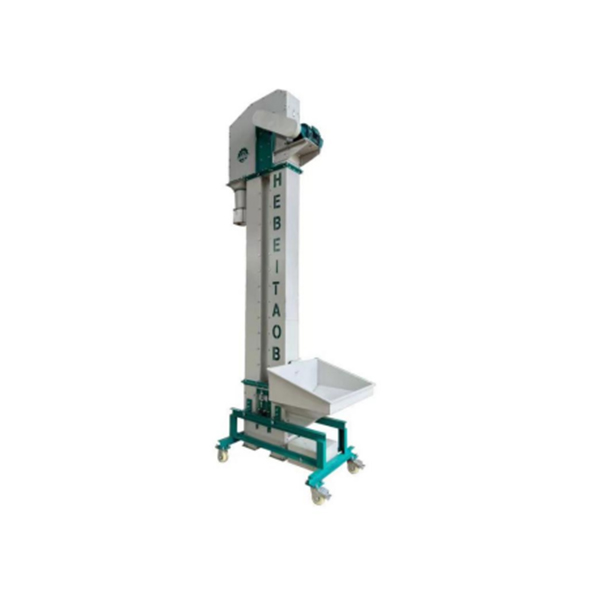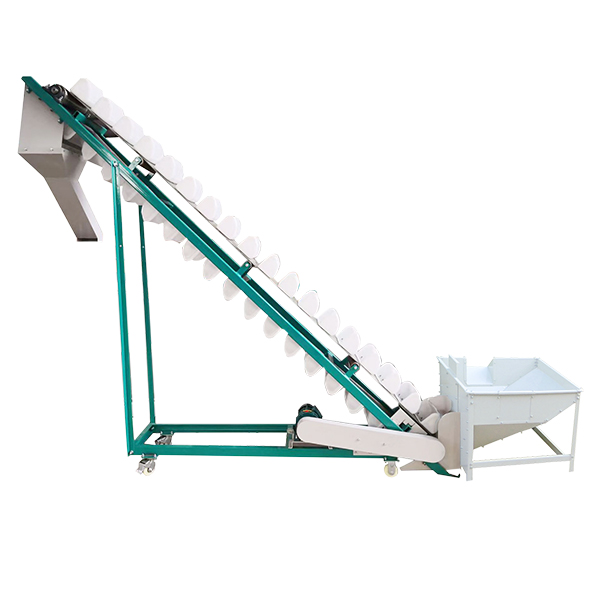Bucket elevators are the mainstream vertical lifting equipment in grain and bean cleaning systems. Their core function is to scoop materials into buckets for high-altitude conveying, making them suitable for large-scale processing scenarios.
Core Structure:
* Bucket: The core load-bearing component, available in deep, shallow, and pointed bucket types, selected according to material characteristics.
* Traction Component: Divided into chain type (high load-bearing capacity, suitable for heavy materials) and belt type (smooth operation, low noise).
* Casing: A closed structure to prevent material spillage and dust overflow, protecting internal components.
* Drive Unit: Composed of a motor, reducer, and sprockets/rollers, providing traction power.
* Tensioning Device: Adjusts the tension of the traction component, ensuring stable operation and preventing slippage.
Working Principle: The motor drives the traction component (chain or belt) to rotate the buckets. The buckets scoop material from the bottom inlet, rise vertically to the top with the traction component, and are then ejected from the discharge port by centrifugal force (or gravity) into subsequent equipment (such as cleaning machines or silos), completing the lifting and conveying process.
Applicable Scenarios and Advantages
Suitable Scenarios: Large-scale processing scenarios such as grain purchasing stations, oil pressing plants, and soybean product factories, for feeding raw materials from the ground to elevated silos and cleaning machines.
Core Advantages: Small footprint, high lifting height, large conveying capacity, good sealing performance, reducing dust pollution and material loss.
Inclined conveyors are commonly used inclined conveying equipment in grain and bean cleaning processes. They utilize inclined tracks or conveyor belts to lift materials short distances at low angles, suitable for raw material feeding and process transitions in cleaning lines.
Core Structure:
Conveying Body: Available in three types: belt conveyor, chain conveyor, and roller conveyor. Belt conveyors are the most common, chain conveyors are suitable for heavier materials, and roller conveyors are suitable for free-flowing granules.
Frame and Incline Adjustment: The frame uses a steel structure, with partially adjustable inclination angles (typically 15°-45°) to accommodate different lifting height requirements.
Drive Unit: A motor paired with a reducer controls the conveying speed, ensuring smooth material transport.
Side Guards and Guide Structure: Side guards are installed on both sides of the belt or chain conveyor to prevent material slippage. Guide chutes are provided at the inlet and outlet to optimize material flow.
Working Principle: Material is fed into the conveyor body (belt/chain/roller) from the inlet. The drive unit tilts the conveyor body, and the material moves upward with the conveyor surface under the action of friction (or side retaining forces). Upon reaching the outlet, it falls into the cleaning machine, hopper, or other downstream equipment, completing the lifting and conveying process.
Key Features: Advantages: Simple structure, easy installation and maintenance, moderate footprint, suitable for short-distance (typically ≤10 meters) and low-height (≤5 meters) lifting.
Suitable Materials: Granular grains and legumes such as wheat, corn, soybeans, and red beans. It can also handle raw materials containing a small amount of impurities, with a low material breakage rate.
Precautions: The inclination angle should not be too large (over 45° is prone to slippage). The material must be dry and free of lumps. For belt conveyors, the anti-slip and tension should be checked regularly.
Key Scenarios and Adaptability Differences:
Bucket Elevators: Suitable for “small space + high lifting” needs, such as feeding materials from ground-level stockpiles to elevated silos or large cleaning machines, adaptable to large-scale processing scenarios.
Incline Elevators: Suitable for “long distance + low height” connections, such as material transfer between cleaning equipment and short-distance loading, offering flexible installation and adaptable to small to medium-sized sites.
Elevators are primarily used to lift the following materials:
Grains: Wheat, corn, rice, sorghum, barley, oats, etc., suitable for shallow buckets or trough buckets, offering high conveying efficiency.
Legular crops: Soybeans, red beans, mung beans, kidney beans, peas, broad beans, etc., shallow buckets are selected for uniform grain size, while deep buckets are preferred for damp or shriveled grains.
Oil crops: Rapeseed, sesame, sunflower seeds (hulled), cottonseed, etc.
Miscellaneous grains: Buckwheat, millet, sorghum, highland barley, and other small-grained grains.
Seeds: Various crop seeds (such as corn seeds, soybean seeds, vegetable seeds), with gravity-discharge deep buckets preferred to reduce breakage rates.
Post time: Nov-12-2025










